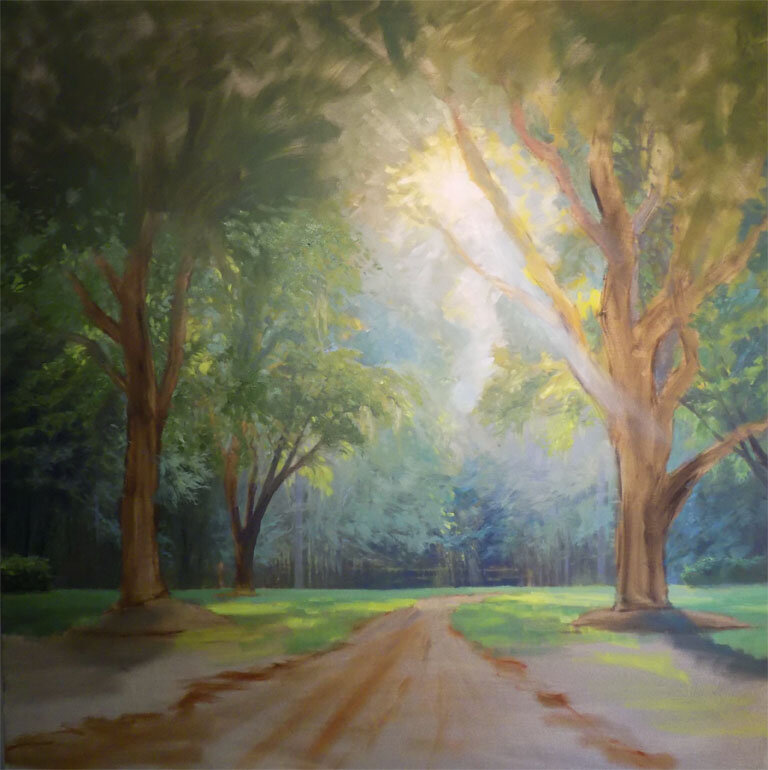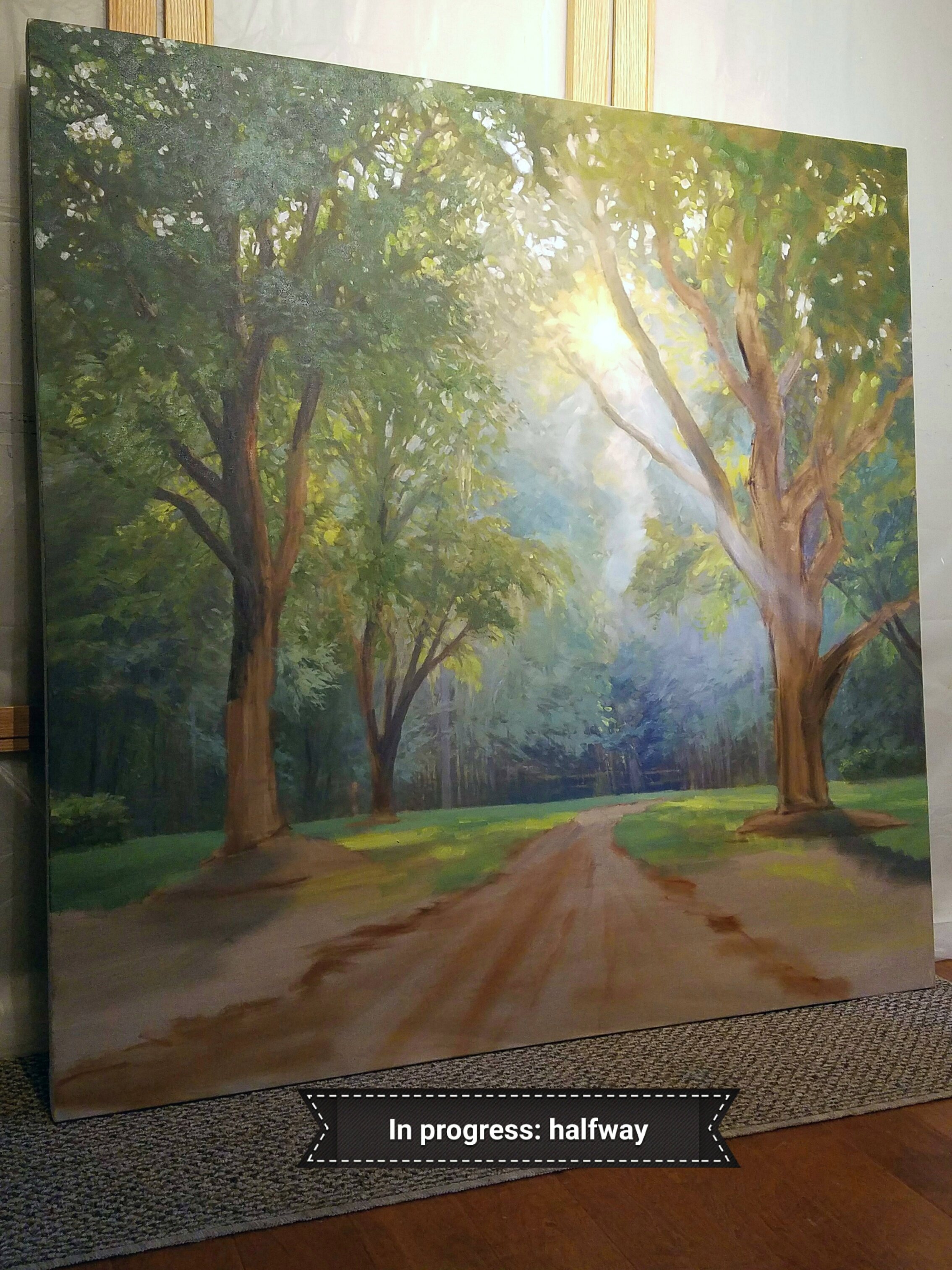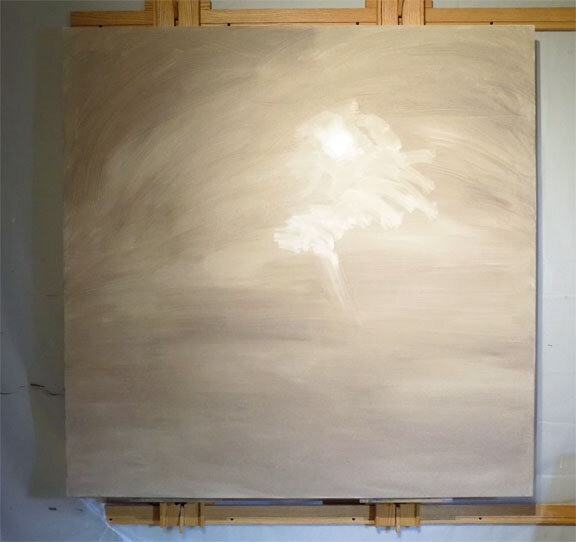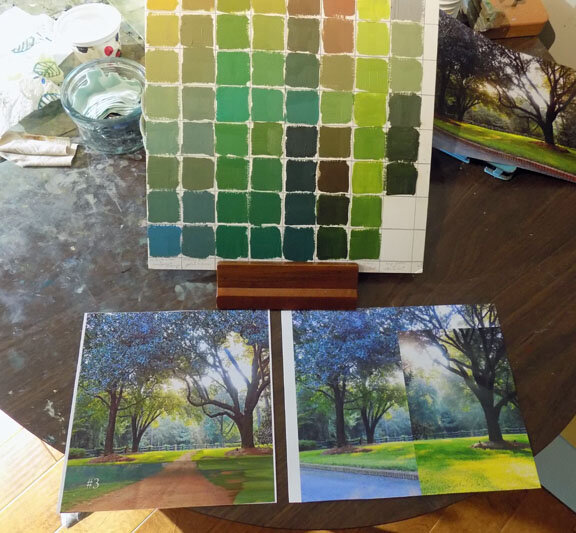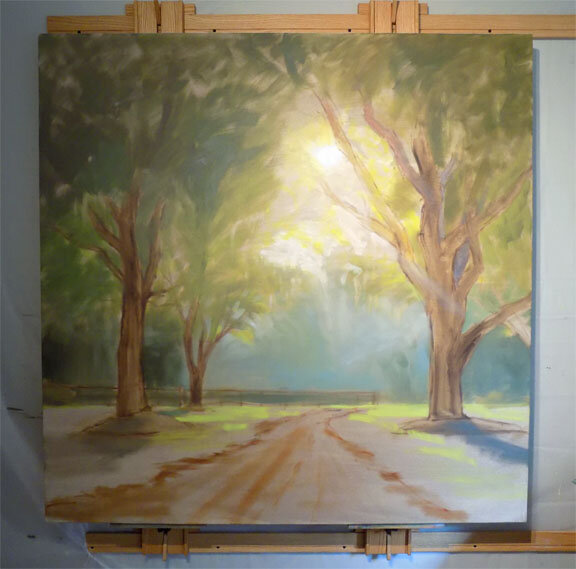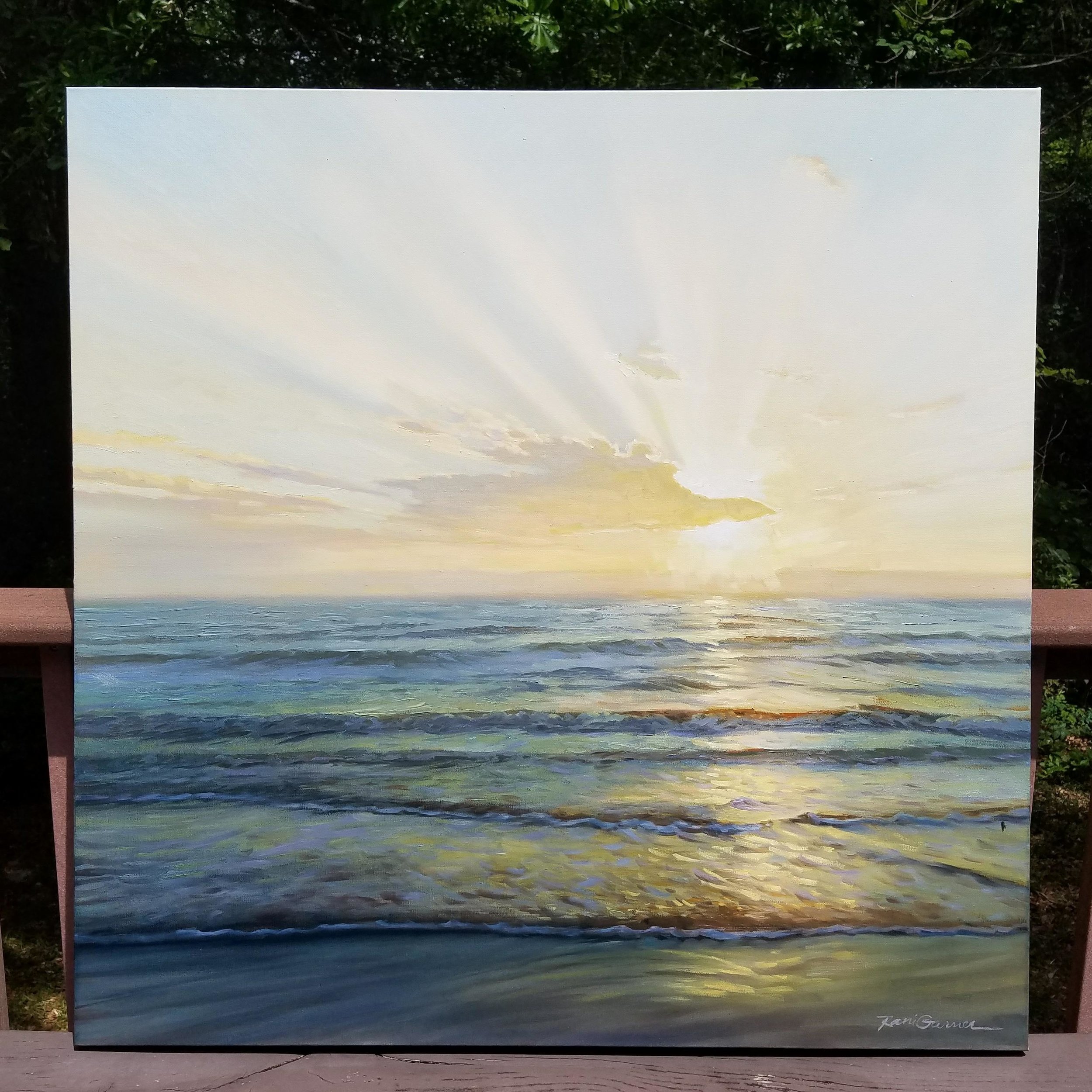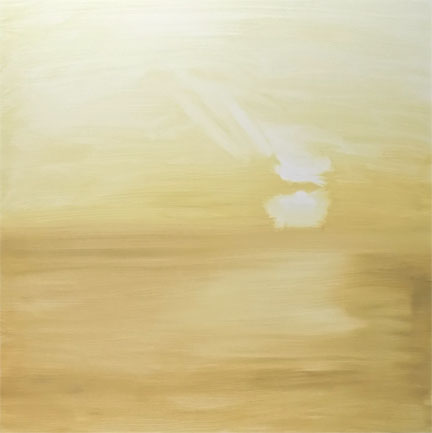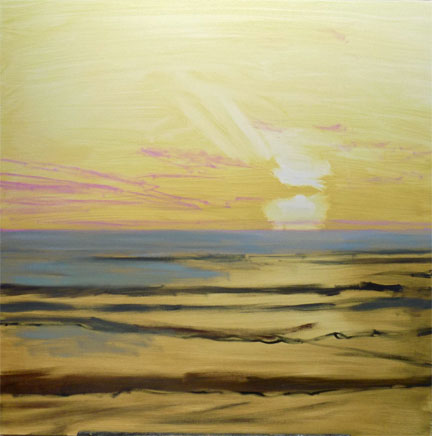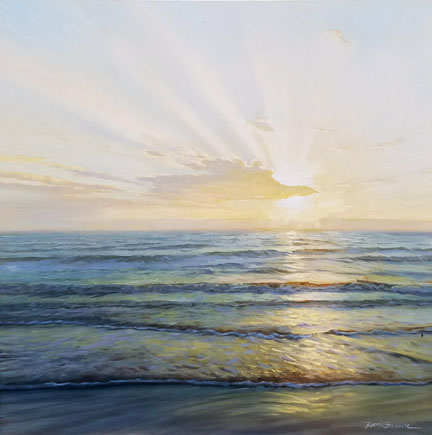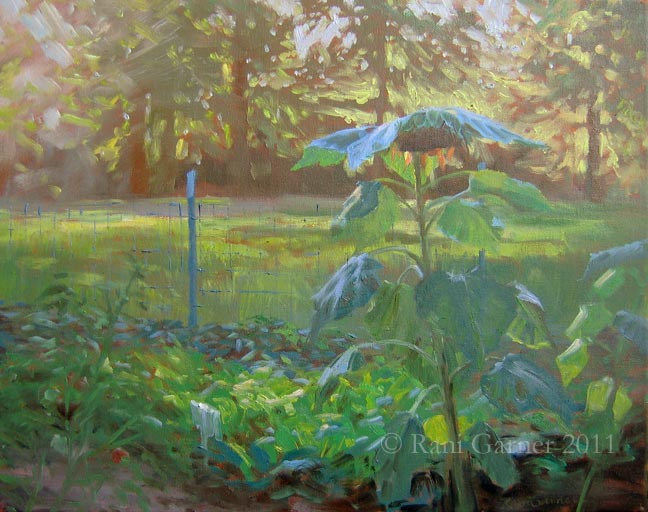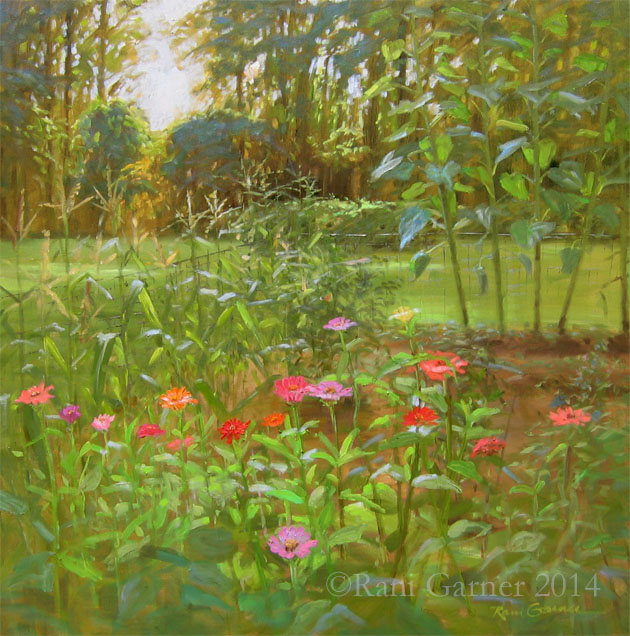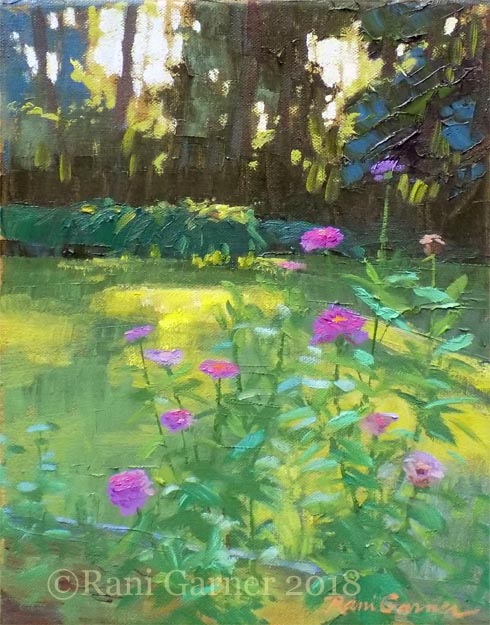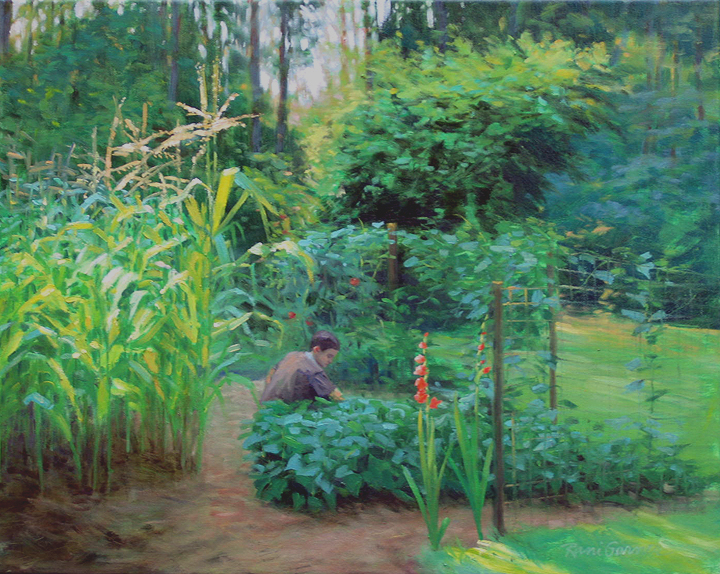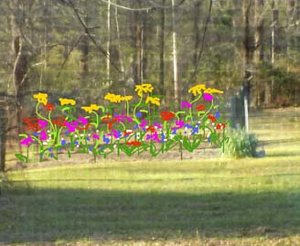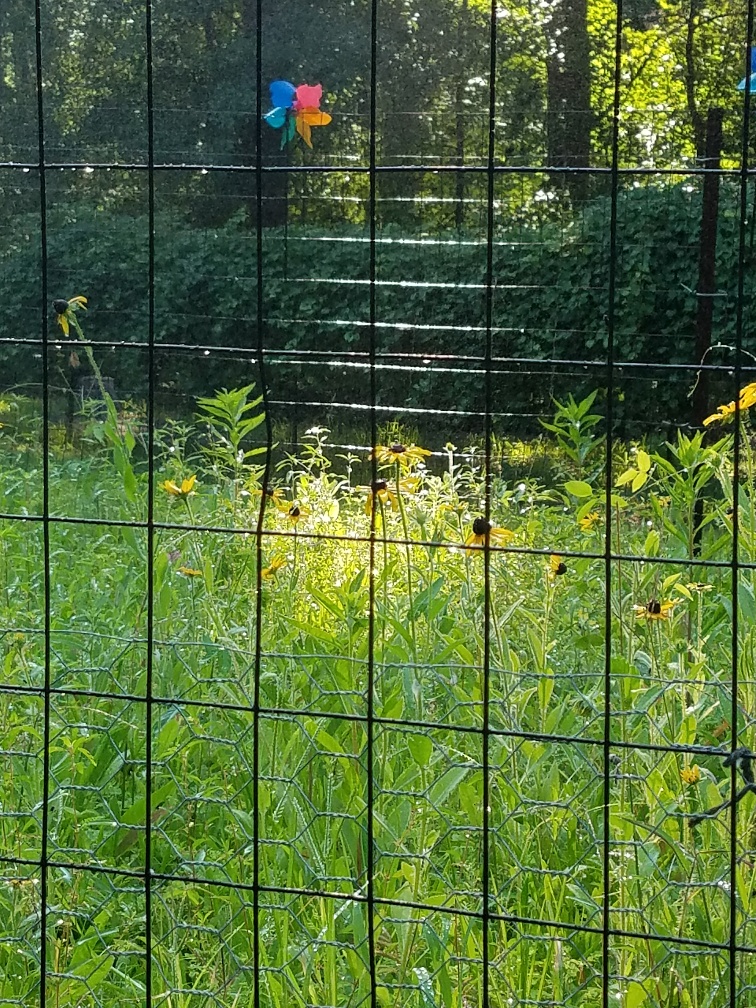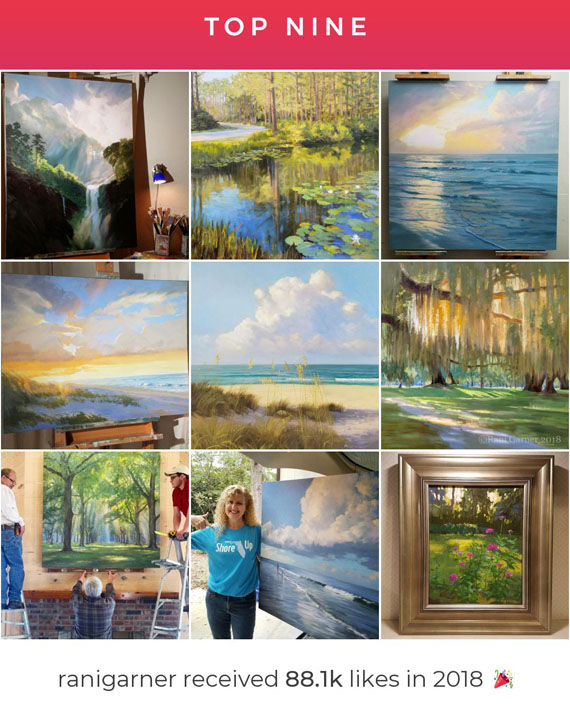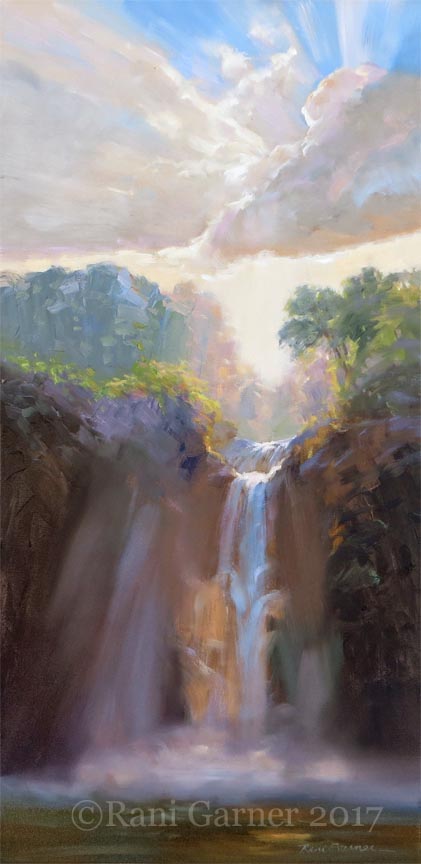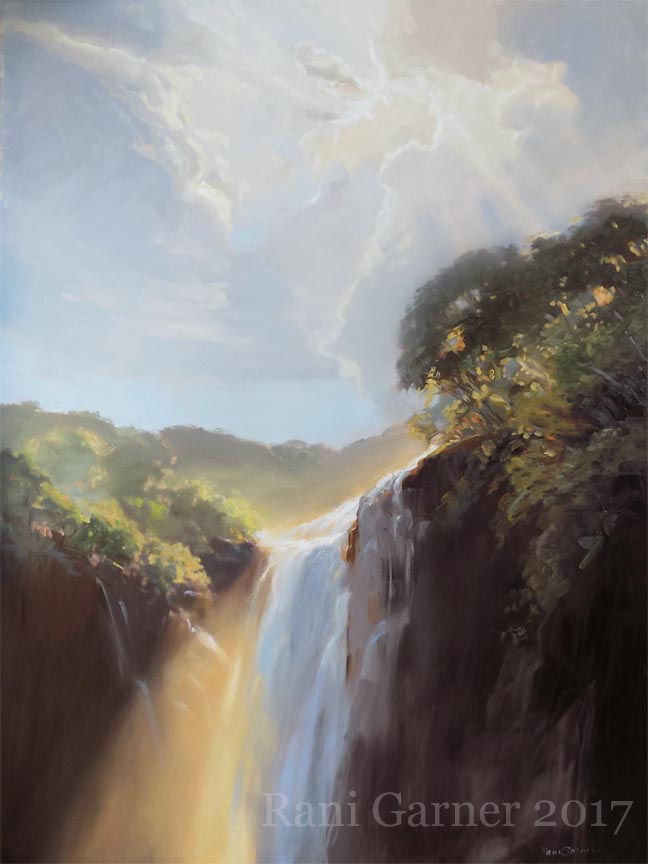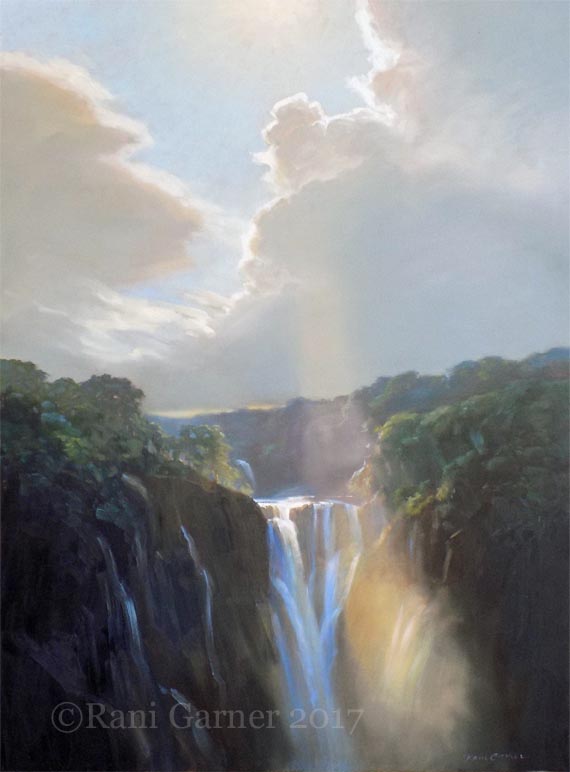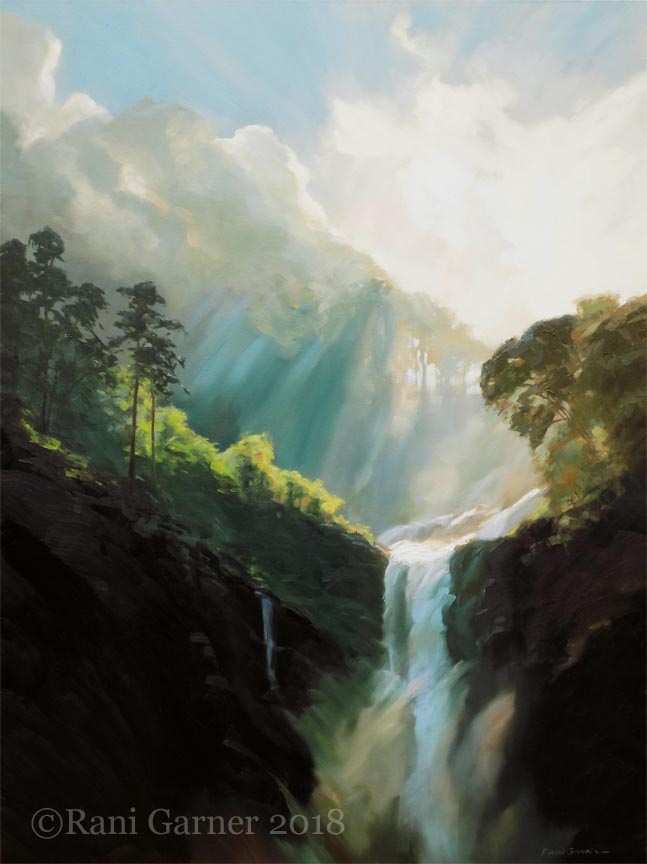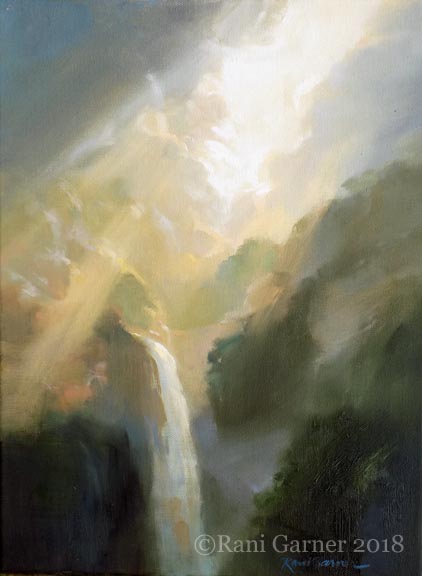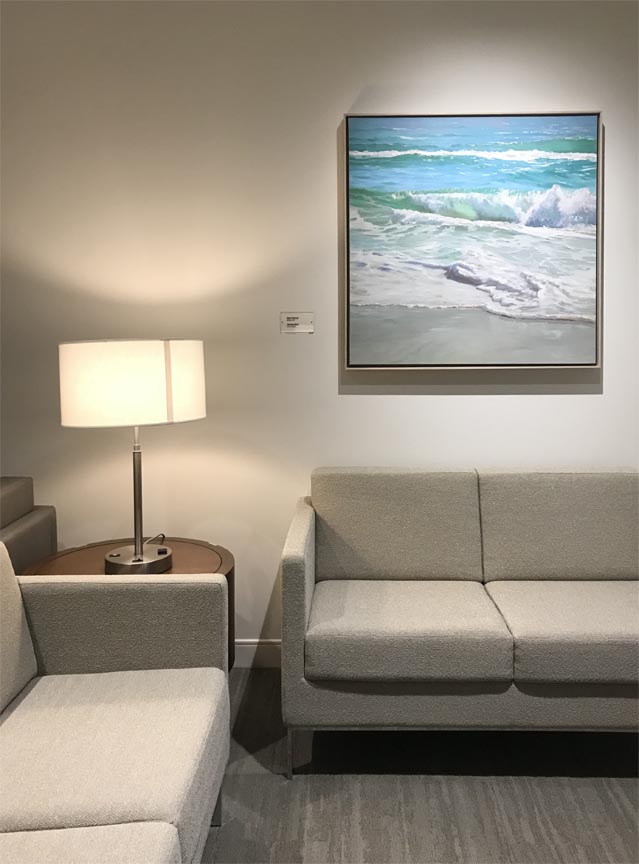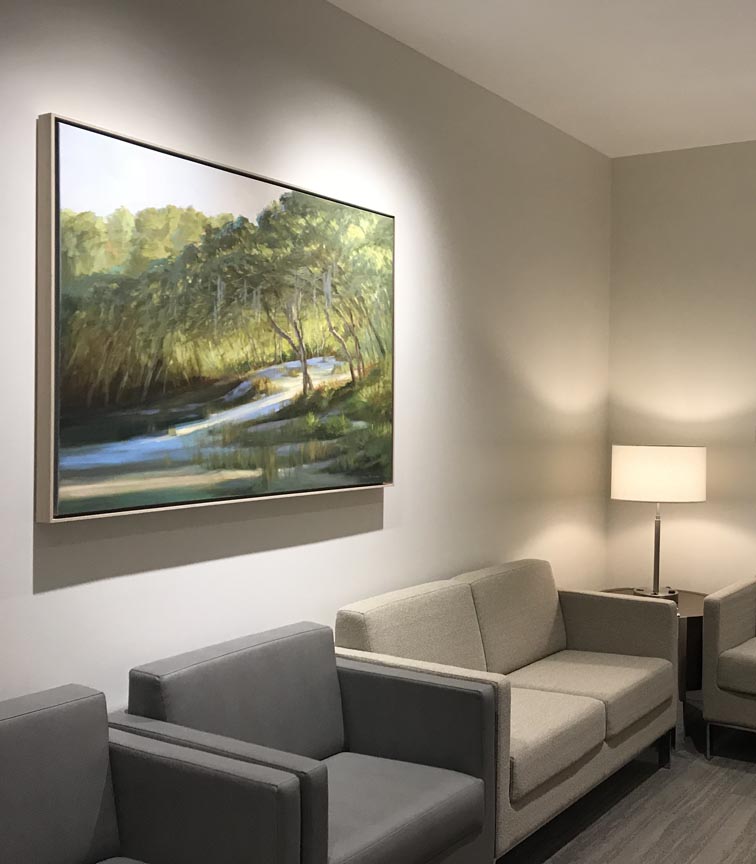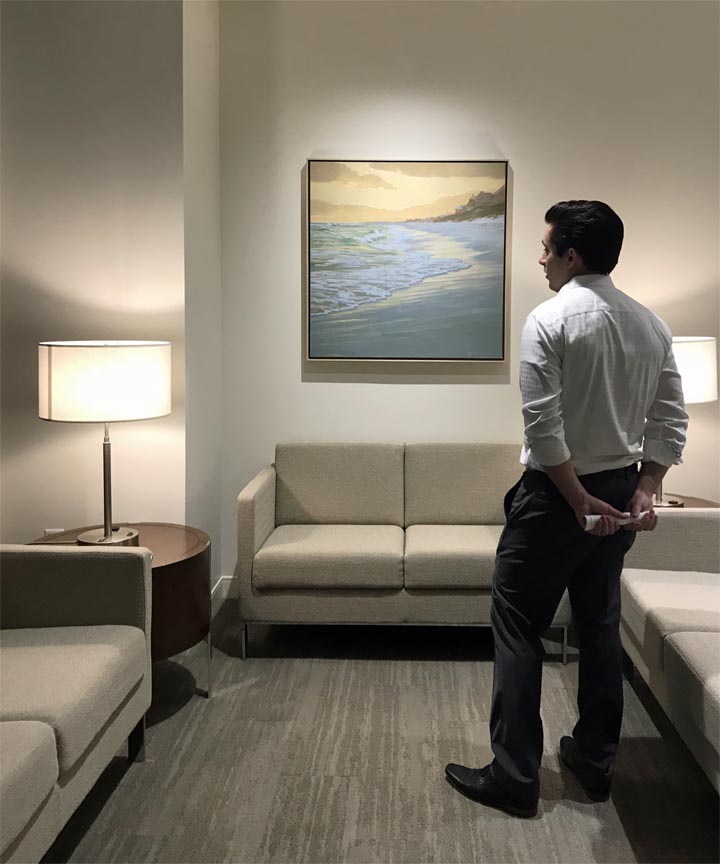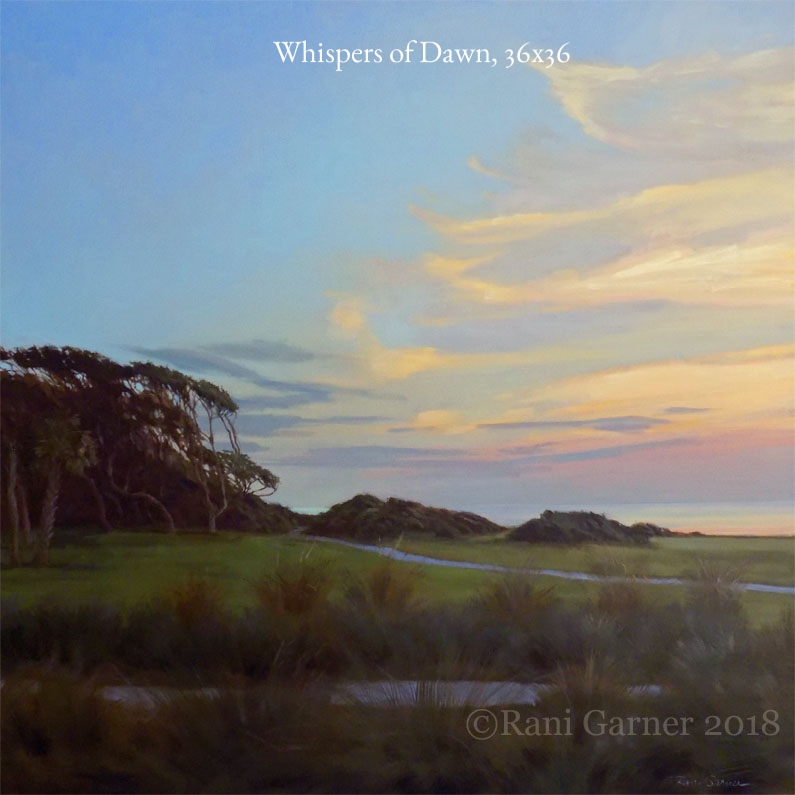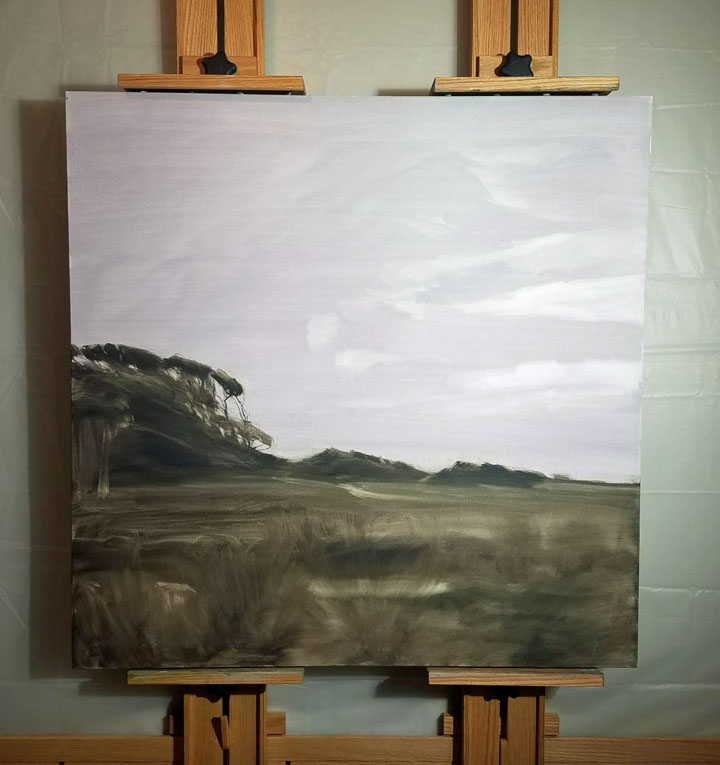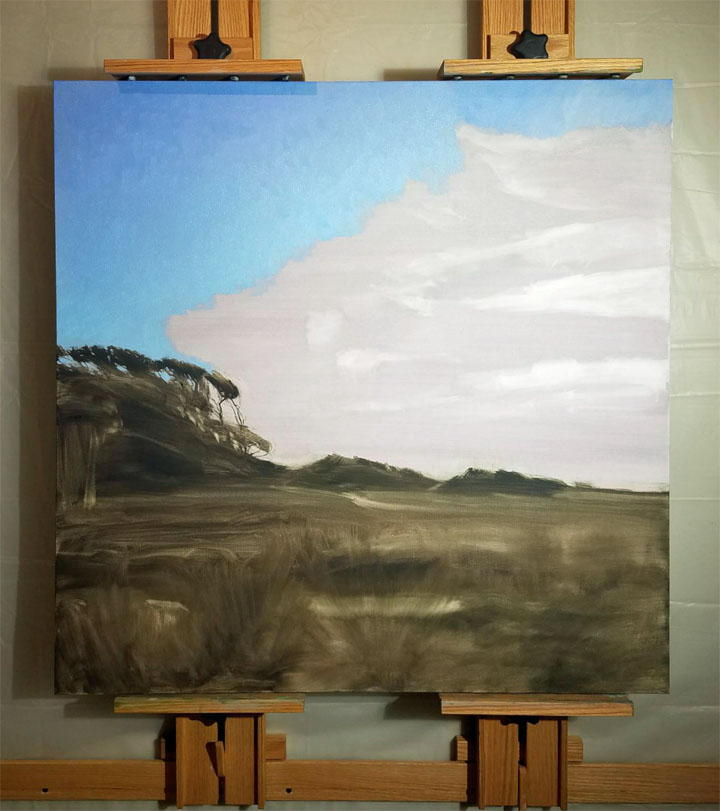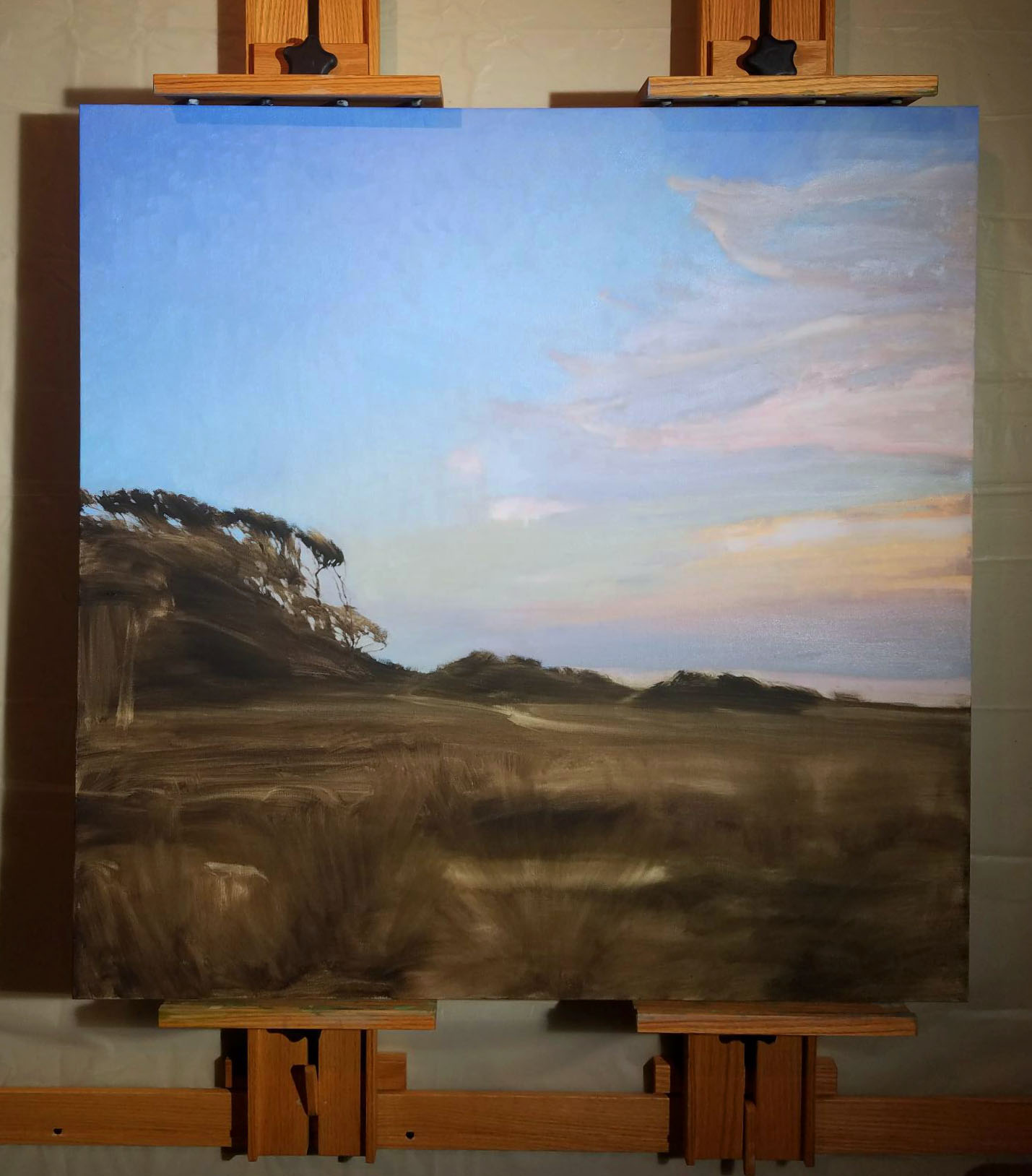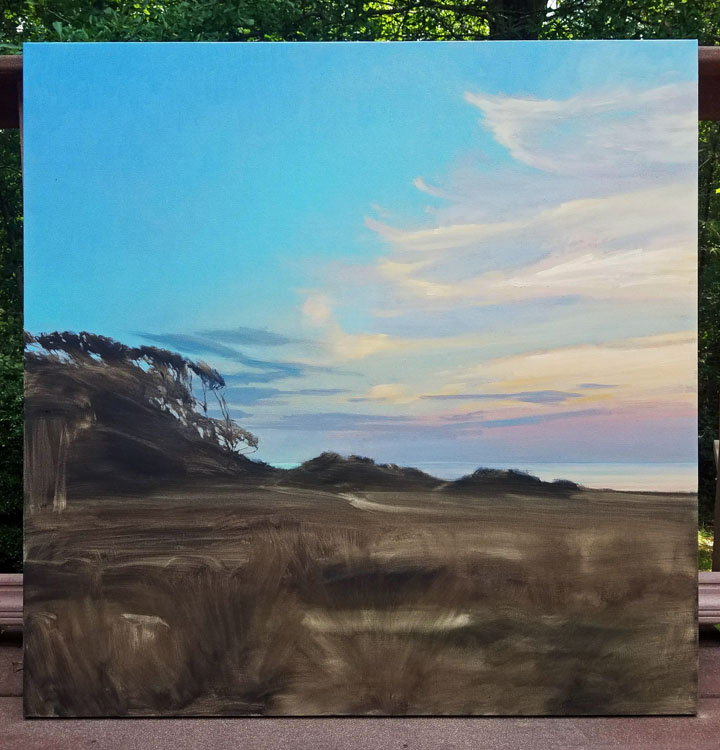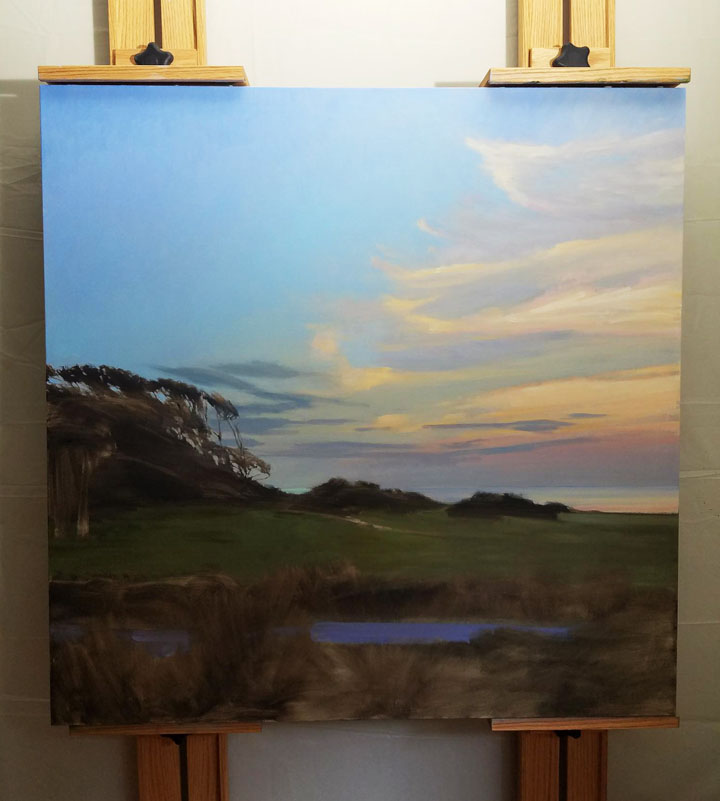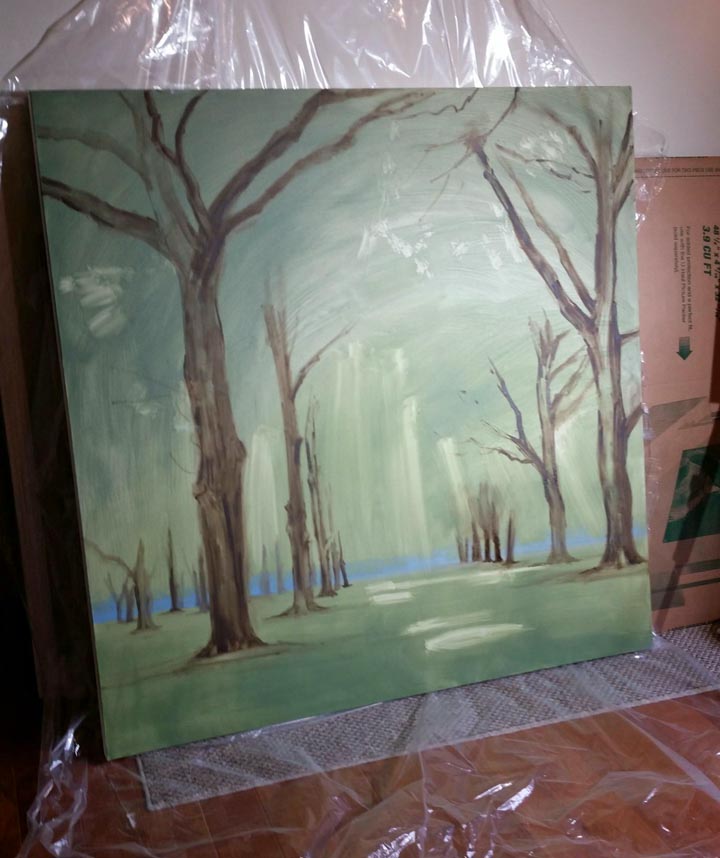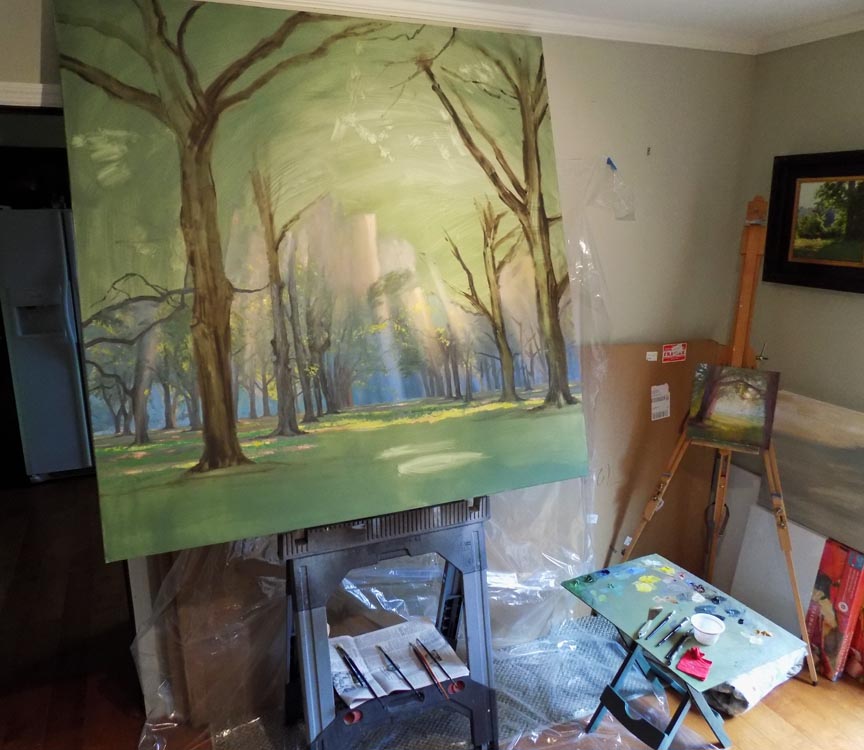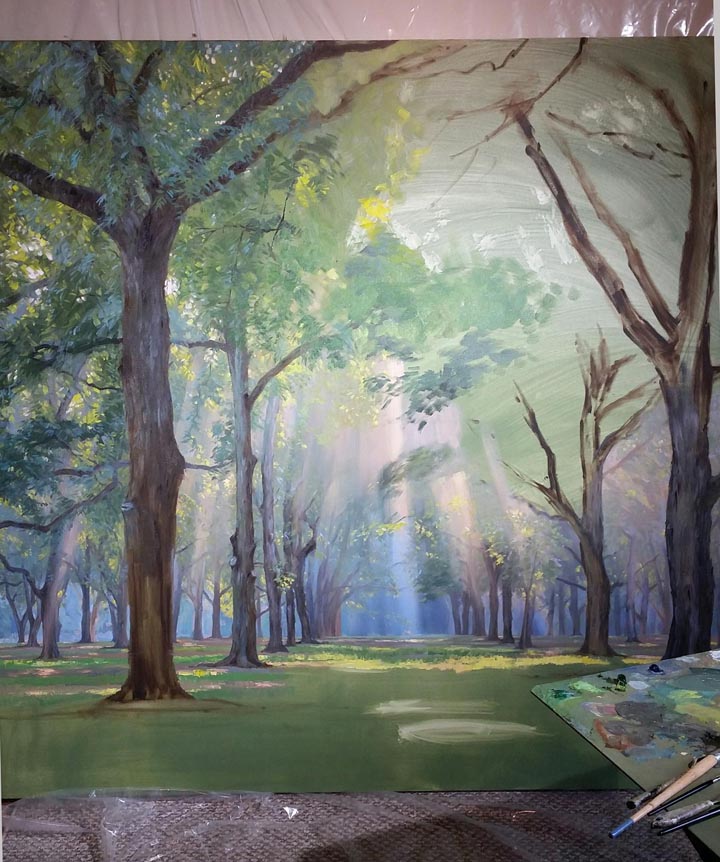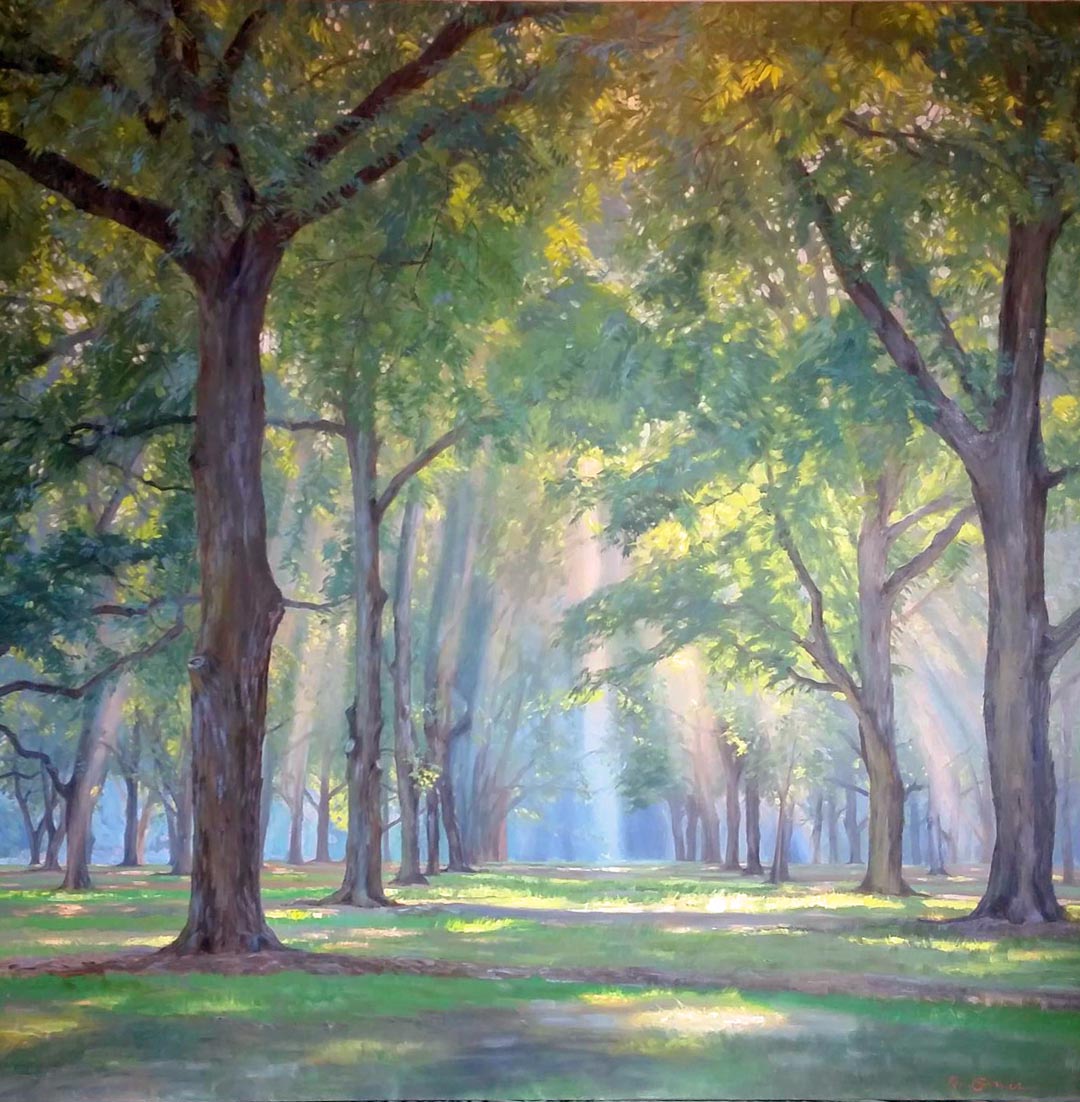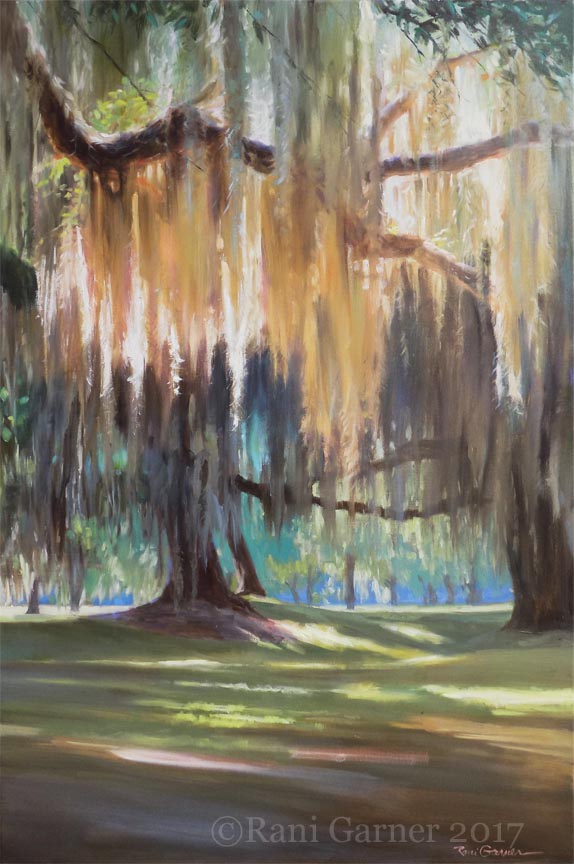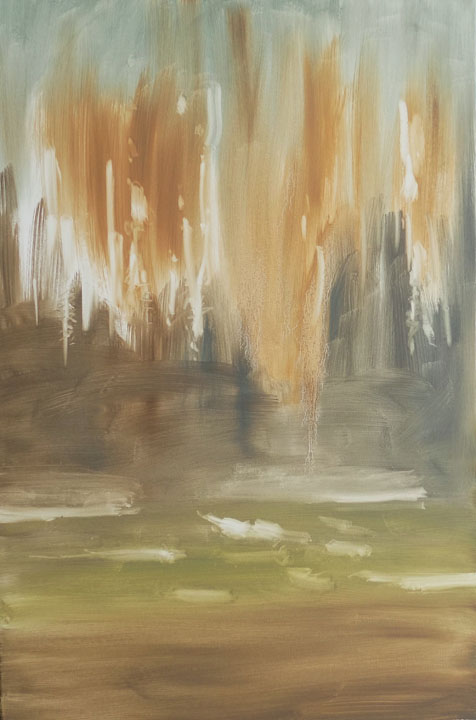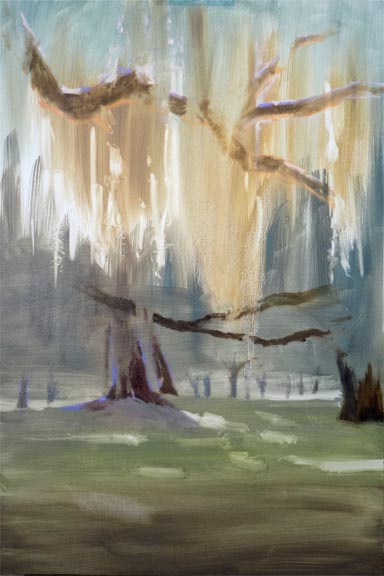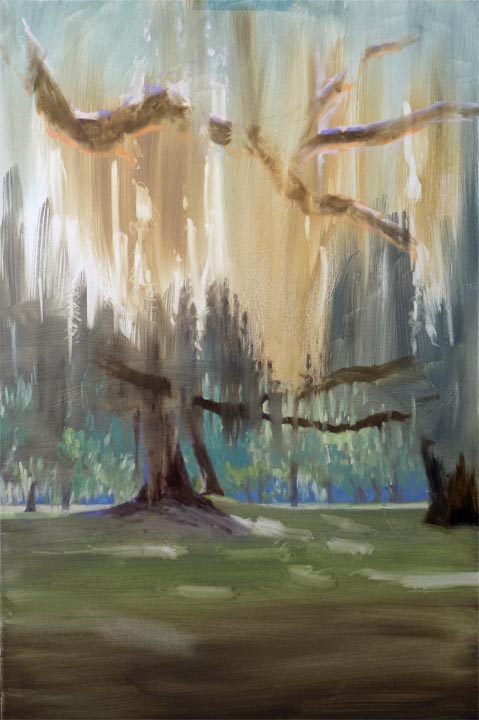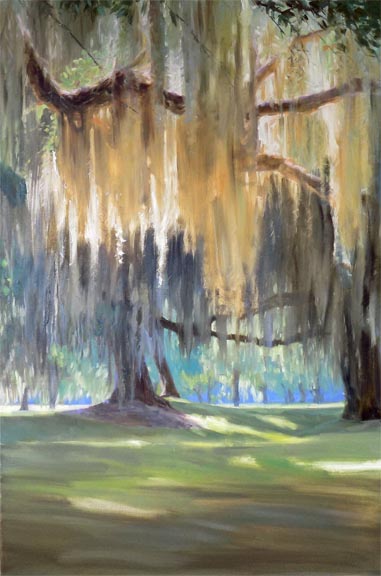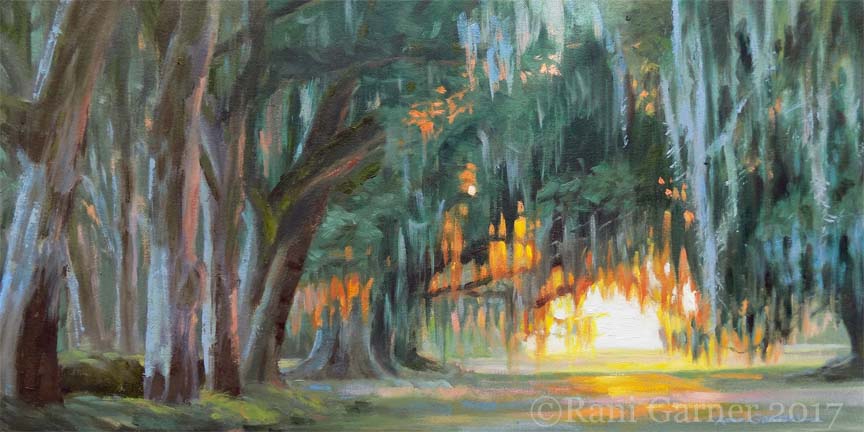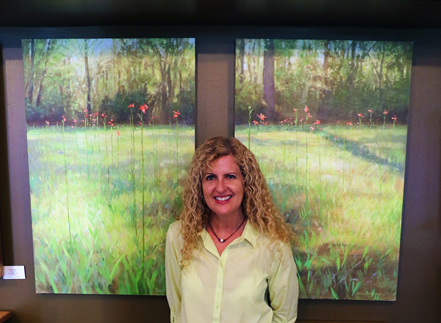Here are the next two stages of a 55x55 painting in progress. I work from the background forwards, and you can see I’ve been developing the foliage in the upper half. I really want to paint the trees themselves, but they’re in front of a fence that is next to be painted.
The Creation of a Project for a Commercial Space, Part 2
Here is an update on a painting in progress, a gallery commission for a new restaurant being built in South Carolina.
Client to decorator to gallery to artist is the flow of communication, coordinating to work out the details on a project like this. The size for the painting couldn't be decided until more of the wall and window trim work had been installed, but we finally got the decision: it needed to be 55” x 55”. Being a custom size, I had to special order the canvas from a supplier in Houston, TX, who shipped it via freight. Sixteen days later, the canvas was uncrated and placed on my wall easel.
So what's next? How do I begin such a large painting? I am no longer intimidated by a giant-sized blank canvas, and I really love starting large paintings with large paintbrushes and big arm movements. I toned the canvas with my favorite underpainting color: thinned Raw Umber. An underpainting helps me establish some of the future values and gets rid of bright white canvas that might otherwise peek through later stages. While this was wet, I used a small rag to wipe out the lightest light: the sun and its surrounding area (first photo). I allowed it to dry two days. In this way, when drawing/placing the trees, I could wipe off to make changes without disturbing the underpainting.
The second step was to examine my reference photos, which I'd already printed out. I got out my color chart of different recipes for green (second photo) and decided which main colors I was going to use: in this case, Phthalo Blue and Yellow Ochre will give me a range of greens from warm to cool. I will also use some Sap Green mixed with Raw Umber for the warmer dark greens and a little Cadmium Lemon Yellow mixed in for the lightest leaves and grass. Tints and shades made from Burnt Sienna mixtures will later create the red dirt road and hints of warm sunbeams streaming through the branches.
If you look at my reference photos, which are not that great, you will see they are heavily Photoshopped. I've added the road and flipped the tree on the right around to give it a better shape! I do stuff like this all time, taking great liberties with what was really there.
The next stage of the painting (third photo) was to “draw” the trees on the canvas with thinned paint. This was mentally tiring, but I enjoyed it. I don't use a projector or grid lines, I just hold up my photo to sight size to place the lines in approximately the right spot on the canvas. Trees have gestures and I took my time getting all the twists and angles drawn, though I left out some of the branches I thought were distracting. Then I drew, with paint, the horizon line, thinly blocked in the trees, a few shadows, and the tree canopy. I also used a straight edge to place fencing in the background. I laid out the road and finished by starting with the background color, one of my blue/ochre mixes. I love how it's looking already! I'll let this dry a few days before starting with the thicker paint.
The Creation of a Project for a Commercial Space
I have a lot of work to do. I should be painting right now! I’ve just gotten back from an out-of-state trip for an upcoming project and thought I’d share a little of the process. From someone’s initial request, how does the artist get the ball rolling with all the decisions to be made?
I was contacted by my gallery who has clients opening a new restaurant. They’ve actually bought my work in the past and were interested in a large painting of light-filled trees as the centerpiece over the site’s fireplace. I was already planning a trip to the coast, so what’s another few hundred miles to go meet with them—I agreed. I met the owners and their decorator on site, took notes of what they had in mind and photographed the setting, measuring the fireplace width. Then I followed the owner to the location of the trees they wanted in the painting. More notes. I also photographed an idea they liked from a book with a red dirt road, which turned out to be useful later on. I came back in the evening when the light was streaming through the trees to my satisfaction and made the rounds of the area with my camera. I think of these as Light Safaris because I’m trying to be in the right place at the right time to capture the elusive lighting I want in my paintings. I came back early the next morning and did the same thing before heading home.
The gallery had already discussed framing, pricing and sizes in preparation for a contract. My note taking mostly consisted of what they wanted as far as subject matter. Once home, my first step, as always after a photo expedition to a new place, was to look through my raw photos, making a note of which images would work for the project. Next, after waiting a day, I went back to those photos and looked more closely, opening them in Photoshop to begin cropping, resizing, adjusting lighting and color, and placing elements I’ve clipped from other photos. As an example, I actually cropped a section of the red dirt road from the photo I took of the book and pasted it into my photos in a grassy area with the right trees, and it looks amazingly good, though I hadn’t planned on doing this. I saved all these edited photos in a folder for the project, then looked at them the next day, selecting those I thought would look best in the space. I also prepped the image I’d taken of the fireplace in the room of the restaurant where the painting will hang and then pasted each of the painting ideas, to scale, onto the fireplace to show what it would look like in situ. This should give everyone involved in the selection a good idea of the finished piece. Then, I emailed all the photos to the gallery to pass on to the decorator and owners. I will keep you posted on the project.
Artists: 5 Reasons to Update your Website Now
Artists: Do you want to sell more paintings, get invited into galleries and group shows, get selected for large corporate art projects, and have your artwork published in books? All these things have happened to me as the direct result of having an updated website.
I am an artist who has made a living selling my paintings through galleries and art consultants. It would be hard to count the number of times an opportunity for gallery representation or a large project came my way because someone was able to view my current portfolio on an updated website.
Artist friends often ask me how they can get their own career going, and I usually tell them that this is the main thing they can do right away: get a website and keep it updated. It isn't that expensive, or to put it a better way, it is money well spent. If I was able to teach myself how to build one using an online service, they can too. I've known a dozen or so friends who pay someone else hundreds of dollars to design their artist website and then it never gets updated because someone else has control of it. That's why I recommend doing it yourself. If you update it often, then it never becomes a big chore you don't want to do.
If you don't have one yet, you'll have to do some research to find the right fit. I am very happy with mine, and even though I don't get tons of traffic, I know it helps collectors see my latest work, and this assists in gallery sales. If you're one of the many artists who has a website but never updates it, let me give you five good reasons to change your ways!
1. People who see your work somewhere and want to buy it will search your name online, find your latest work and how to purchase it.
2. Collectors who have bought your work in the past will check back frequently to view your new work if they see that you keep it updated.
3. Galleries are on line looking at artist websites all the time! They may see an image on social media or in a magazine, look up the artist's name and browse their paintings. Most of the galleries I am currently represented by invited me in after viewing art on my website.
4. You may get into invitational group shows if the curator/gallerist can see your work online.
5. Corporate projects become within the realm of possibility for you. I have worked with several over the years and enjoy doing large, site specific paintings for them several times each year. Let's say an art consultant is putting together a proposal to provide the artwork for a hospital expansion. They have to make a presentation with budget to the selection committee. The ones that I work with know they can browse my website, download any images that fit the project and use it in their presentation (I have given them permission to do this). That existing art is used as the basis for a larger one for the project if approved.
You never know who is looking at your website. It could be someone looking for exactly the work you create. Don't you want them to see your best, latest art?
Painting in Progress: the stages of "Corona"
“Corona” is my newest 36x36 oil painting. I used a limited palette: Torrit Grey, Titanium White, Cadmium Yellow Medium, Cerulean Blue and Quinacridone Magenta. This was painted from a photograph I took on Jekyll Island, Georgia, but I added the sun rays. Here it is in various stages so you can see how I work: (click on the right to advance the photos):
Garden Goals
I’ve enjoyed having a vegetable garden ever since moving to the country 17 years ago. There are always a few flowers included, and zinnias have been slowly taking over the past few seasons. My work keeps me in the studio much of the time, but I make it a point to set up outside for at least one garden painting. Here are some of them (all are sold):
2019 brings a different goal for my garden. As my art career has gotten busier, I have less time to devote to the care of raising vegetables. So my plan is to sow wildflower seeds, shifting its purpose to be more of a painting inspiration. (Okay, I can’t resist throwing few tomato plants in too, and oh yeah, some bell peppers.) The only place I can plant flowers is in my fenced garden space because of the herd of deer that also lives here, eating all my roses, bulbs, blueberries…they’re even chiseling away at the azaleas and camellias, which they didn’t used to bother.
I invite you to check back later this summer when I’ll post an update on the progress of my Artist Garden!
Photo courtesy of TopNine.com
8 Ways Instagram has Made Me a Better Artist
This is not a post about how to get more followers. I just wanted to share with you some thoughts about Instagram, which is a fantastic venue for artists to share their work with the world.
1. By following selectively, I can see top artists' work in progress, get glimpses of their studio or learn their plein air setup. I can study their work and analyze what makes their art appeal to me. This helps in the development of your own artist’s eye.
2. This makes me want to pursue excellence too. It’s a basis of comparison for my own work and its shortcomings.
3 Instagram posts are a daily dose of inspiration. It’s full of artwork and photography and you can find whatever it is that appeals to you—gardens, beach life, outdoor adventure…..
4. I can quickly save and categorize posts I want to refer back to. For instance, I have a category for saved color combinations I like and want to try and one for show invitation design ideas.
5. I find that my posts inspire others!
6. It is a great source of feedback on my work, once I gained a following. It has even led to sales.
7. It is a small though real connection to someone on the other side of the world from me! I treasure these exchanges that I would never have had otherwise. I enjoy translating international comments and attempting to reply back in their language.
8. I have found a community of fellow artists with similar careers. It’s nice to know that while I am diligently working alone in my studio, they are doing the same thing in their corner of the world.
If you decide to try IG, my advice is to stick with it! I see a lot of abandoned accounts out there. I went two or three years with only a handful of people following me. One of the best ways to gain a following is to use #hashtags (you can research this topic). If you want people to follow you for your art, post only artwork or related items—not your pets, family, or too many selfies. Post only your best work. And if you want to be better at what you do, follow UP. Follow superior artists. If you follow everyone back, your feed will not be a source of inspiration, but will become an overwhelming chore to scroll through to find the treasure you really want to see. You don't have to follow all your friends and family or everyone who follows you.
I welcome your questions and suggestions—please leave a comment!
Sowing Seeds
Artists apply for lots of shows, competitions and projects, and I have come to think of this as sowing seeds. Some sprout and come to fruition in wonderful ways we never imagined, and this is the story of one of those instances!
Back in early 2017 I submitted a proposal for a VERY large scale set of paintings for the two-story foyer of a new hospital being built in Jacksonville FL. In 2015 I had provided a large diptych for another branch of this same hospital through an art consultant, so when I saw this listing I was very interested and my wheels started turning. After much development and refining I submitted my proposal, and I was eventually notified that though mine hadn't been selected, I and other artists were being placed on a list to provide artwork for other public areas of the new hospital.
(In the meantime, I went ahead and painted my proposal idea but on a much smaller scale, and that has become a successful series that even led to another recent corporate commission. It has been fun to get to develop my idea anyway and has yielded seven paintings so far…pictured above)
Tick. Tock. Many months pass. Six months later I got an email stating they were still intending on using my art in the hospital. And then another six months passed and I contacted them, but did not get a response. At this point, we were so near the projected completion date that I reasoned they had hired a decorator and gone in another direction.
So I'm working away in my studio as usual and a day comes in late May of this year when I receive one of those emails artists dream about getting. Here is an excerpt:
“....Unbeknownst to you, we have been admiring your artwork from afar for some time now. :) Your paintings are beautiful, bright and evoke such light and energy. I am drawn to your work and know that our collectors/market would be as well.
I am working on a large healthcare project in Jacksonville, FL and you have been on our "roster" of artist for 18 months. I would love to connect on available artwork for both possible inclusion in this project as well as the opportunity to show your work in our gallery.....”
How exciting! It was from the owner of a gallery I was very familiar with in the Jacksonville area, and it dawned on me that they must have gotten tapped to coordinate gathering the artwork for this new cancer center. There was a very limited amount of time left before the big installation and ribbon cutting, but the gallery was easy to work with and we quickly agreed on four large commissioned paintings and several smaller ones to be used in a waiting room and other public areas. Below are photos of the paintings in situ, courtesy of the gallery, which better shows their scale. Two of them are 36x48 and two are 36x36, and getting this project was a big part of making 2018 by far my best year ever for sales and productivity. It is exciting to have big projects from time to time to supplement my regular work of supplying art galleries and I look forward to applying for more.
Sow those seeds....you never know what it could lead to.
Follow-up to a Solo Show
As an artist, I see many notices about art show openings at galleries. Exciting as they sound, I don't often make it to the receptions. I seldom see the show mentioned again, and I wonder how sales were. Why don't artists talk about their sales? Well, some do and are obviously excited and in love with the world after a successful show, but usually it's silence. If you're wondering how mine went, here's the scoop....
Earlier this year I was invited to have a solo show at a wonderful gallery in my state. I've had a long career and more than a handful of solo shows, but I've never had one that was wildly successful. Never a sellout, like some artists I've heard about. The best results were six sold at a solo show in North Carolina, but I've had one or two-person shows that sold nothing at all—yikes. (Blessed be the group show, where all the pressure and attention is not on you!) So this time, I had no high expectations.
I had several months to prepare the work, and I was able to deliver twenty new paintings, mostly large, to the gallery in June. They had arranged a painting demo for the morning of the show, which I enjoyed very much. After two hours of talking while painting, I was completely exhausted. Nice group of people though, about half of them artists. Here's the painting I did:
Your Majesty, a 20x20 oil painting (SOLD)
That night's reception went very well, and I was so pleased at getting to meet people who'd bought my work. My husband and I really enjoyed the evening, and as a treat, we got to meet a celebrity who happened to be in town and is a friend of the gallery! Bob Schieffer and his wife came to the show opening and it was a real pleasure to talk with them. He's an artist and is quite good! Here's our picture:
Bob Schieffer from CBS!!!!!!
As for sales, it was a thrill and a relief to have sold the largest painting the day before the show. Another piece sold at the reception. But I have found, to my utter amazement, that the gallery has gone on to sell most of the paintings from the show in the two months since! This is wonderful and definitely a new experience for me. To other artists, all I can say is that I work very hard at painting; I try to do excellent work; I am receptive to what gallery owners say about my work and what they'd like to have; and I give most of the credit to the galleries and their wonderful collectors. And to buyers and fans of my artwork, my most sincere thanks!
Stages of a Painting: Whispers of Dawn, 36x36 oil painting
This shows the stages of a new painting in progress. Whispers of Dawn, available soon at Anderson Fine Art Gallery in Saint Simons Island, Georgia. (Click on the right side of the image to advance the slide show.)
Countdown to an art show: Frame Takeover!
countdown to an art show: frame takeover!
Read MoreOak Tree painting in progress
Here are the stages of my 30x30 oil painting King of the Castle. I loved the gesture of this magnificent oak tree alongside the Jekyll Island Club Hotel. Its shape reminded me of a chess piece (hence the title), but it was really all about the light.
My Number One Marketing Tip for Artists
There are lots and lots of artists out there pursuing art and an art career. Just as there is no one way to paint, there is also no one path to a successful career as an artist. It is a journey full of growth and learning.
I come across much that is written for artists about marketing their work. I also come across the work of many artists who are marketing like crazy when perhaps they should be focusing on something else.
So here is my Number One Marketing Tip for Artists. It can be condensed down to two simple words, but here it is in full: Don't pursue success. Pursue Excellence. Then, success will likely follow.
If you strive for excellence in what you do, good things will happen and doors will open to you. Galleries will invite you in instead of the other way around. While skillful marketing is a plus with all the online opportunities artists have now, no amount of marketing will compensate for artwork that is not the very best you are capable of. As to what makes art excellent, that is a big mysterious question with many answers! If you're a realist painter, learn the drawing skills needed. If you're abstract, learn about color harmony or composition. And whatever kind of art you make, know what it is you are passionate about and make sure you're communicating that to the viewer.
Best wishes on your journey!
Installation Day: Sunstream Pecans
Hanging Day!
Read MoreSunstream Pecans painting in progress
This is a very large canvas (60"x60"). I began by toning it a soft medium green, wiping away a few of the lightest spots. When that dried, I drew the main trees with thinned brown paint. Then I painted the furthest background, gradually moving forward due to all the overlapping branches and leaves. Sunstream Pecans, a project for Pearson Farm, 60x60.
Stages of a Painting
Click on the far right to see this painting from start to finish, in stages.
"How long did it take you to paint that?"
People often ask me, “How long did it take you to paint that?” I have a variety of answers to this common question, some of which I've gleaned from other artists' musings on the subject.
I usually say something like “Oh, I work on it on and off for a week or two—maybe 8-10 hours total” though I don't keep track of or even think about how long I'm taking to paint something. The problem with this answer is that, to them, it might sound like I'm not working very hard or long on artwork that is priced in the thousands. I would like to say that it's taken me thirty years of working to get good enough to paint it in a short amount of time, which would be true! Years of experience means less time “fixing” things in the painting, plus knowing how to begin or lay the groundwork for future stages.
It is also true that I spend an equal amount of time not painting, but planning the composition and subject and then thinking about how I'm going to paint it and what colors to emphasize. I think it is of utmost importance to know what the painting is about. Whether working from life or photo references, it is connecting strongly with something about what you're looking at that is the essence of the painting, and this strong connection will carry you through to the end. You are painting your response to what inspired you to paint. For me, it can be something as small, subtle or vague as a suggestion of a light effect I can emphasize in the painting. Once I've started, I spend a lot of time just looking at it and thinking about how I'm going to proceed. I guess this counts as painting time too.
I am not offended when asked this question, but I do try to take the time to educate people on the process if they're interested enough to ask it!
Painting in Progress
Here are the stages of a typical painting of mine while in progress. My favorite way to begin is to tone the canvas with thinned paint and, using a rag, wipe away the light areas to create the drawing. This also establishes the values and light effect I want right from the start. When dry, I add some lines and dashes of color to get started. I like to work from the background forward, pretty much alla prima.
Anatomy of a Corporate Art Project....
...or how a broken lawn mower led to a lucrative commission!
Chapter One: Inspiration
Our riding lawn mower was broken and repair took awhile. Spring had sprung, and some tiny little weeds shot up tall in our front yard. One afternoon, I realized how lovely the delicate little sunlit lavender blooms looked against the shadowed azaleas in the afternoon light. I ran for my camera and later cropped the photos into a composition that appealed to me. At the time I had been wanting to paint something with a more contemporary flavor for my gallery in Atlanta. The result was "Yard," a 40x30 oil, pictured.
A little while later, I painted a 36x48 diptych version on two vertical gallery-wrapped canvasses, changing the flowers to red.
Chapter Two: You Never Know Who's Looking at Your Website
One day I received an email from an agent for a regional corporate art consulting firm. They were interested in my providing a price quote for a large version of the diptych I had painted, "Leaves of Grass." The consulting firm had a large hospital expansion project in Jacksonville, FL and was interested in two 48x60s. I gave them my price plus the cost of shipping/delivering. Not long after, I got the contract! There was a bit of a rush to get the paperwork going so I could be paid a deposit and get started. At the time, I was in a gallery in Jacksonville and wanted to combine a gallery delivery trip with hand delivering the finished project paintings to the art consultants, who were going to be in Jacksonville installing some of the artwork in a few months. But the agent was in California, I was in Georgia and the art consultants were in Tennessee, which was no problem except for having to buy and install the right software so I could e-sign the contract, etc. That took time, and then I had to figure out how to use the software and sign my name, initial pages, etc. Did I mention I was in a hurry? Oh dear....
me with original Leaves of Grass diptych
